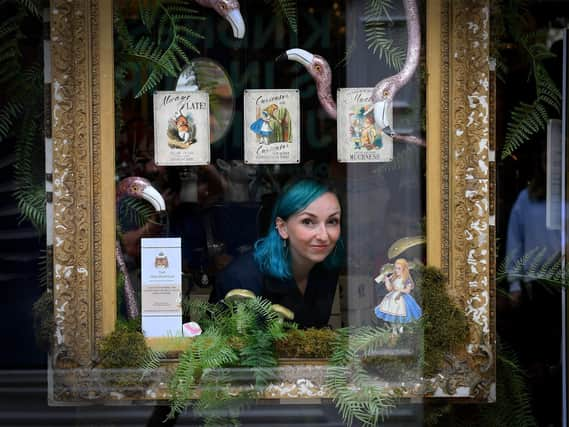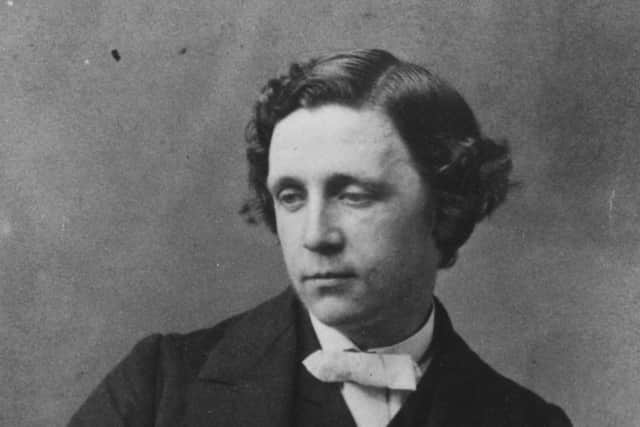Lewis Carroll and the impact Yorkshire had on him and books like Alice In Wonderland


Reverend Charles Dodgson writes him a letter full of fairy-tale jokes and flamboyant imagery.
“As Soon as I get to Leeds I shall scream out in the middle of the street, Ironmongers, Ironmongers. Six hundred men will rush out of their shops in a moment – fly, fly in all directions – ring the bells, call the constables, set the Town on fire. I WILL have a file and a screwdriver and a ring…”
Advertisement
Hide AdAdvertisement
Hide AdDodgson Snr threatens extravagant destruction if these items cannot be found: “At last the Mayor of Leeds will be found in a soup plate covered up with custard, and stuck full of almonds to make him look like a sponge cake…”


Lewis Carroll, the mathematician, poet and author of Alice In Wonderland and Through The Looking-Glass, is associated with Oxford but Yorkshire shaped him too.
Born in Cheshire, Charles Lutwidge Dodgson (aka Lewis Carroll) moved to the county at the age of 10 or 11, when his father took on a new parish at Croft on Tees. The family lived in the rambling rectory and the children entertained themselves and each other, writing poetry in a family magazine.
Dr Franziska Kohlt, editor of The Lewis Carroll Review, believes Yorkshire shaped the young writer. “There’s so much about the culture of Yorkshire reflected in those letters. If you spend your early childhood and teenage years in a place, that’s going to change you and shape your imagination.”
Advertisement
Hide AdAdvertisement
Hide AdCarroll visited Whitby seven or eight times, and in November 2008 a blue plaque was unveiled at the Rosa Hotel where he stayed.
He went to Whitby in 1854 as a 22-year-old student of Christ Church in a mathematical group. One member of his party, a Dr Thomas, is said to have recalled that Dodgson “used to sit on a rock on the beach telling stories to a circle of eager young listeners”.
Years later, Carroll wrote in his diary: “Aug 16, 1871: I can only now record generally that my stay in Whitby was on the whole very enjoyable, and that the ‘Arithmetic Examples’ made no progress whatsoever.”
Franziska is a researcher in science communication at the University of York and studies science narratives and her book, Alice Through the Wonderglass, will be published by Reaktion Press next year.
Advertisement
Hide AdAdvertisement
Hide AdHer interest began young, after she asked her mother to take her to the Disney film, then devoured the books. It’s a passion that has remained with her.
In November, Franziska is hosting an online event to mark the 150th anniversary of Carroll’s lesser-known Alice story. ‘Through The Looking-Glass Sesquicentenary Conference’ will explore the significance of the mirror in literature, science, theology, art and other fields.
“If you look at Wonderland it’s the story, a very familiar pattern, Alice falls down a rabbit hole, it’s an underground journey and lots of narratives have underground journeys. Think of Greek mythology, every hero at some point has to descend into the underworld and encounter grotesque figures to negotiate with and get past, and that’s very much what Alice does.”
Through The Looking-Glass is more experimental. “Carroll really pushed boundaries with what he could achieve. That we in a way are still fascinated with the Alice stories, but we avoid talking about Through The Looking-Glass, that really fascinated me.
Advertisement
Hide AdAdvertisement
Hide Ad“What I want people to do is come back to it with a fresh pair of eyes, re-read it and see what ground-breaking stuff Carroll was doing in the book. I find it really exciting as a piece of literature and it pushed a lot of boundaries, it brought in all of these socially critical aspects without really saying that they’re in there.”
Next month’s online event will feature researchers, performers and artists from around the world and Franziska herself will chair a session on ‘ Science and the Imagination’. “We’ve got a fantastic, surrealist artist from Brazil who is joining us, and her illustrations are incredible, and she is doing an interactive art installation online. Then we have musical contributions, we have the curators from the big Alice in Wonderland exhibition in London joining us from the V&A.”
Franziska came to Alice after studying literature and the history of science, particularly of the Victorian age. “What I thought was interesting is that a lot of people who studied the sciences ended up writing literature and a lot ended up writing fantasy literature, and that’s not two things you would intuitively put together.”
Charles Dodgson was a mathematician with a deep interest in the sciences and the natural sciences, medicine, psychology. His library contained possibly 4,000 books, many about science, and he corresponded with scientists of the day, including Charles Darwin.
Advertisement
Hide AdAdvertisement
Hide Ad“I became particularly interested in Lewis Carroll because there is such a misconception about the man himself. He’s always considered a children’s author and everything else he did in life is always considered at odds with that. When you take a bit of time to study Lewis Carroll, you see that children’s literature was just an extension of what he already did. He was a very devout Christian and mathematics to him was the study of truth and how to measure it, and he called mathematics his work for God.
“That’s what makes Through The Looking Glass so interesting, because the first book was successful so he knew he could take a few more liberties, he could be bolder about what he wanted to put in.”
Dodgson has been portrayed as having had an unhealthy interest in photographing girls, but Franziska feels much of the evidence for this has been undone by recent research.
“He photographed quite a lot of children of families, but photography was new and when you look at his letters alongside his photographs, you see that the parents asked for photographs of their children to be taken.”
Advertisement
Hide AdAdvertisement
Hide AdStephen Folan, chairman of the Lewis Carroll Society, sees Through The Looking-Glass as a fun story that was “way ahead of its time”.
“It is full of memorable characters such as the Red Queen and the White Knight and there are fantastic scenes such as Alice talking to the food at the final banquet. The story is dense with ideas such as travelling through time, the nature of dreams and how our memory works. It is like The Hitchhiker’s Guide To The Galaxy for children.”
Through the Looking-Glass Sesquicentenary Conference, November 4-5, takes place online. For more info visit throughthelooking
glasssesquicentenary.wordpress.com